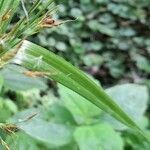Perennials. Rhizomes short. Culms erect, 60-140 cm tall, stout, 3-angled, with several nodes, smooth or scaberulose on angles. Leaves basal and cauline; sheath semirounded, 2-6 cm, membranous, ligulate at mouth; leaf blade broadly linear, 30-60 × 0.9-1.7 cm, flat, herbaceous to thinly leathery, margin and abaxial midvein scabrous, apex long acuminate. Involucral bracts 3-5, leaflike, shorter than inflorescence, base sheathing. Inflorescence a large compound panicle consisting of 2-5 distant corymbiform anthelae, 20-50 cm; anthelae compound, to 15 cm in diam., ± dense, diffuse, many branched; bractlets setaceous. Spikelets many, in clusters of 2-5, erect or obliquely patent, narrowly ovoid to fusiform, 7-10 mm; basal flower bisexual; apical 1 or 2 flowers male. Glumes 7 or 8, ovate to ovate-lanceolate, basal 4 and apicalmost empty. Perianth bristles 6, as long as nutlet, antrorsely scabrous. Stamens 3; filaments shorter than nutlet and style base; anthers linear; connective subulate. Style ca. 1.7 cm, base dilated; stigmas 2. Nutlet brown, oblong-obovoid to obovoid, 3-4 mm, compressed, finely transversely wrinkled in middle part, coarsely undulate rugose toward margin; persistent style base long conic, ca. 5.5 mm, ± as broad as nutlet, compressed, conspicuously grooved on both sides, smooth or asperous. Fl. and fr. Mar-Dec. 2n = 18.
Perennial, with culms scabrous above, stout, 6-10 dm. high; leaves long, 1-2 cm. wide; the several dense corymbs forming an interrupted inflorescence 2-4 dm. long; spikelets very numerous, 6-7 mm. long, containing a single achene; achene 2-3 mm. long, narrowly obovate, faintly reticulate, dark brown, the corky-thickened beak equaling the achene; bristles 6, exceeding the achene, upwardly barbed.







